Best of India Tours
- Golden Triangle Tour- Best of India & Nepal
- Classical Rajasthan
India Cultural Tours
- Images of North India- Karnataka Heritage
- Rajasthan & Goa Tour
Discover India Tours
- Grand India Tour- North to South India
- Central to South India
Rajasthan Tours
- Classical Rajasthan Tour- Golden Triangle Tour
- Grand Mughal Tour
India Luxury Trains
- Palace on Wheels- The Golden Chariot
- India Deccan Odyssey
- The Indian Maharaja
- Royal Rajasthan on Wheels
Nepal Tours
- Glimpses of Nepal- Buddhist Pilgrimage
- Nepal River Rafting
- Destinations of Nepal
- Nepal General Info
India Wildlife Tours
- North India Wild Life- South India Wildlife
Tibet Tours
- Tibet Monastery Tours- Explore Tibet
- Destinations of Tibet
Spa & Yoga Tours
- Ananda in Himalayas- Yoga & Meditation
Adventure Tours
- Manali Safari Tour- Himalayan Trekking
- Horse Safari
Shekhawati
Ajmer
![]() Alwar
Alwar
![]() Bharatpur
Bharatpur
![]() Bijaipur
Bijaipur
![]() Bikaner
Bikaner
![]() Bissau
Bissau
![]() Bundi
Bundi
![]() Deogarh
Deogarh
![]() Jaipur
Jaipur
![]() Jaisalmer
Jaisalmer
![]() Jalore
Jalore
![]() Jodhpur
Jodhpur
![]() Kota
Kota
![]() Mount Abu
Mount Abu
![]() Pushkar
Pushkar
![]() Ranthambore
Ranthambore
![]() Sariska
Sariska
![]() Shekhawati
Shekhawati
![]() Udaipur
Udaipur
Popularly known as the open art gallery of Rajasthan, Shekhawati is an invaluable contribution of the Marwari traders of Rajasthan. This semi-desert region is known for its colourfully painted havelis (mansions) that are commendable pieces of the great artistic tradition of Shekhawati. The name Shekhawati literally translates into ’the land of Shekha’s clan’—a name derived from Rao Shekha of the 15th century and a scion of Kachhwaha family of Jaipur. The region extends over two districts of Rajasthan, namely, Jhunjhunu and Sikar. Most of the havelis were constructed between AD 1750 and 1930 by the Marwaris, but successive droughts forced many of these families to leave the state
For a long period, these havelis remained in sheer neglect and started crumbling when one or two wealthy Marwaris took the initiative in restoring them. The money flowed in the next few decades and the entire region attained great touristic value. The architectural style of the havelis or mansions here evolved mostly around the courtyard. This was done to ensure safety and privacy of the womenfolk from the extreme summers of the region. Most of the havelis are painted in many colours like indigo, yellow, green, maroon, and blue and beautiful wall paintings adorn the walls.
Sightseeing
No other region in Rajasthan is perhaps so rich artistically as Shekhawati. Creating beautiful images by using vibrant colours is not a hobby or professional practice but a way of life. Mandawa is a small town founded in the 18th century by the wealthy Marwari businessmen. Nawalgarh, not far away, is known for some curious images painted on the walls of havelis.
Excursions
Apart from the rich tradition of frescoes seen in Mandawa and Nawalgarh, there are many other lesser-known places in the region. Jhunjhunu and Sikar are the district headquarters known for their palaces and havelis. Dundlod is a beautiful town famous for its fort and palaces. Fatehpur was founded by the Muslim Nawabs, but the Rajputs later took over the place and developed it to their taste.
Excursions for Shekhawati
Mandawa
Mandawa is a small town in the heart of Shekhawati region. The place is known not only for its havelis but also for its Fort Palace. The structure of the palace reminds of the cultural and social importance of this region in the past. Of the havelis, the most important are the Chokhani, Ladia, Binsidhar Newatia, and Gulab Rai Ladia Haveli. Another haveli, the Binsidhar Newatia Haveli, is known for its curious paintings. There is a painting of a boy holding a telephone and a European woman in a car driven by a chauffeur. The Gulab Rai Ladia Haveli is famous for its erotic images, now mostly defaced.
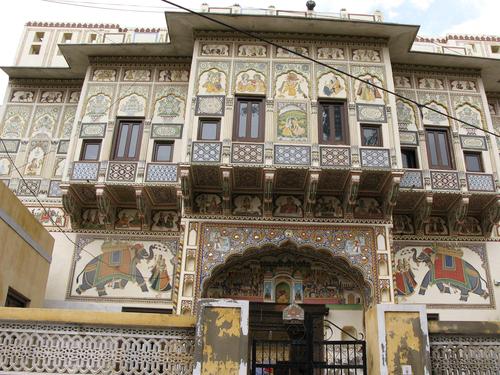
Nawalgarh
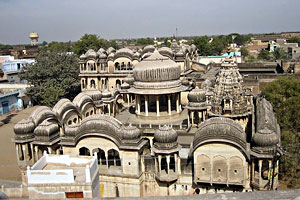
Nawalgarh is famous for its fort that was built in AD 1737 by Thakur Nawal Singh. The Bala Qila has a kiosk with beautiful ceiling paintings while the Roop Nivas Palace has now been converted into a hotel. Like Mandawa, Nawalgarh too has a number of important havelis including Anandi Lal Poddar Haveli, Aath Haveli, Hem Raj Kulwal Haveli, Bhagton Ki Haveli, and Khedwal Bhavan.
Dundlod
Situated around 30 kms south-east of Mandawa, Dundlod has many havelis such as Jathia Haveli, and Tuganram Goenka Haveli. However, Dundlod is better known for its fort and palace. Another famous attraction here is the Satyanarayan Temple.

Jhunjhunu
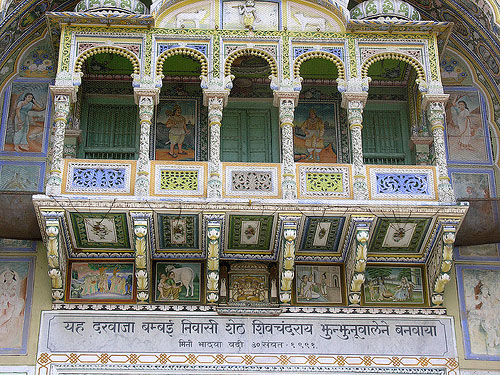
The district headquarters of the same name is also the largest city in the Shekhawati region. Founded by the Kaimkhani Nawabs in the 15th century, the place was taken under control by Rajput ruler Sardul Singh in 1730. The main attractions of the city include the Khetri Mahal, the Bihariji Temple, the Modi Haveli, and the Kaniram Narsinghdas Tiberwala Haveli.
Lakshmangarh
Lakshmangarh was founded in the early 19th century on the model of Jaipur. There are fine havelis including the grand Ganeriwala with its four courtyards
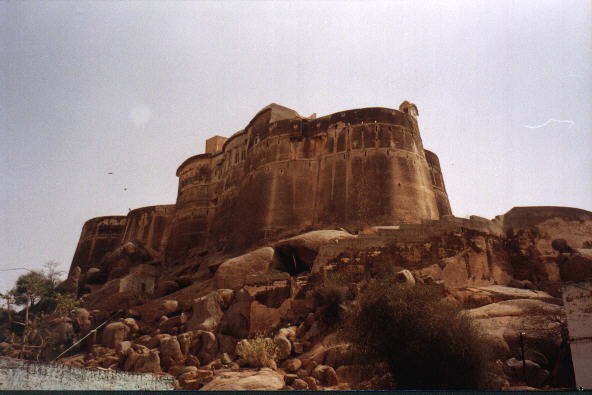
Ramgarh
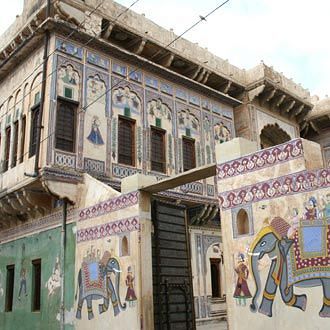
Ramgarh was settled by the Poddars in the late 18th century. Apart from the havelis, there are beautiful chhatris (cenotaphs) with painted entrances and the temples of Shani and Ganga.
Sikar
Founded in the late 17th century, Sikar was the largest ‘thikana’ (feudal state) under Jaipur. The fort and temples of Gopinath, Raghunath and Madan Mohan with commendable frescoes are worth visiting. The jubilee Hall, Madho Niwas Kothi, Biwani Haveli, Sodhani Haveli, the Jain temple and a large market are other places of interest.
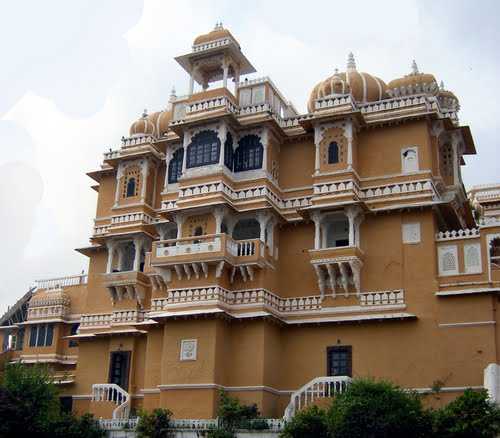
Fact File
 Best Time to Visit:October to March
Best Time to Visit:October to March
 Languages: Hindi, Rajasthani, English
Languages: Hindi, Rajasthani, English
 STD Code:01592 (Jhunjhunu), 01572 (Sikar)
STD Code:01592 (Jhunjhunu), 01572 (Sikar)




